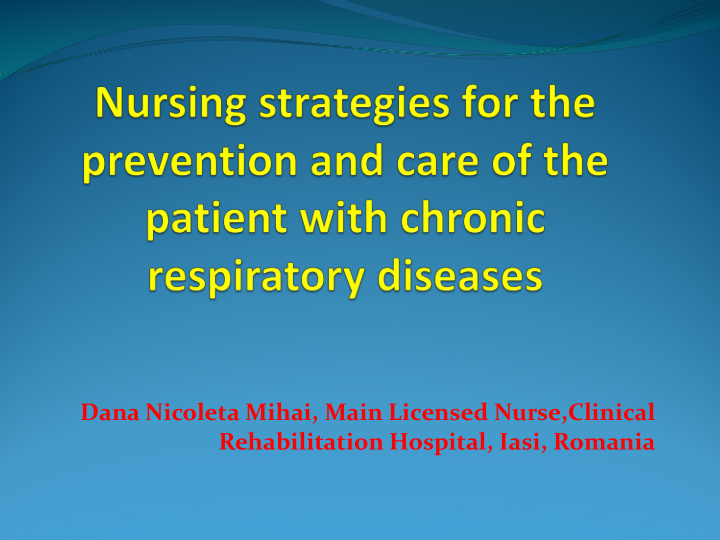



Dana Nicoleta Mihai, Main Licensed Nurse,Clinical Rehabilitation Hospital, Iasi, Romania
Chronic respiratory diseases (CRDs) -diseases of the airways and other structures of the lung. Some of the most common are chronic obstructive pulmonary disease (COPD), asthma, occupational lung diseases and pulmonary hypertension
Chronic respiratory diseases (CRDs) In addition to tobacco smoke , other risk factors include air pollution , occupational chemicals and dusts , and frequent lower respiratory infections during childhood. CRDs are not curable, however, various forms of treatment that help dilate major air passages and improve shortness of breath can help control symptoms and increase the quality of life for people with the disease.
Chronic respiratory diseases (CRDs) Asthma is a chronic, noncommunicable disease characterized by recurrent attacks of breathlessness and wheezing, which vary in severity and frequency from person to person. Symptoms may occur several times in a day or week in affected individuals, and for some people become worse during physical activity or at night. COPD is not one single disease but an umbrella term used to describe chronic lung diseases that cause limitations in lung airflow. The most common symptoms of COPD are breathlessness, or a ‘need for air’, excessive sputum production and a chronic cough.
Chronic respiratory diseases (CRDs Treatments for each chronic respiratory disease vary and the ideal solution is the reduction and avoidance of risk factors . Appropriate management of asthma through medications like inhaled corticosteroids can control the progression of the disease and reduce deaths. COPD is confirmed by a spirometry test, which measures how much and how quickly a person can forcibly exhale air. Symptoms can be treated through medical and physical treatments; however, with COPD in people who smoke tobacco, the most effective treatment available is the cessation of smoking..
Primary prevention Primary prevention of CRDs requires the reduction or avoidance of personal exposure to common risk factors, to be started during pregnancy and childhood. -direct and indirect exposure to tobacco smoke is of primary importance -other shared risk factors that should be addressed include low birth weight, poor nutrition, acute respiratory infections of early childhood, indoor and outdoor air pollutants, and occupational risk factors. - the population must be fully informed about what constitutes a healthy lifestyle, such as healthy nutritional habits, regular exercise and avoidance of tobacco, airway irritants and allergens. -for asthma, primary prevention implies the prevention of sensitization to factors that might subsequently induce diseas e.
WHO strategies
Secondary and tertiary prevention Early detection of occupational asthma is vital to prevent further progression and to ensure cost-effective management. Although long term decline in lung function may not be reversible, Asthma, although not curable, is a treatable disease with preventable morbidity. It is also a known risk factor for COPD. Secondary and tertiary prevention involves avoidance of allergens and non-specific triggers. Optimal pharmacological treatment, including the use of anti-inflammatory medication, has been shown to be cost- effective in controlling asthma, preventing the development of chronic symptoms, and reducing mortality.
WHO strategies
THE NURSE’S ROLE 1.To inform the population about the risk of smoking, exposure to pollutants, allergens, unhealthy diet. 2.To guide patients to smoking cessation counseling programs, to nutritionists and sports instructors, maybe salinotherapy . 3. To supervise the way of self-administration of treatment in patients with pulmonary disorders
Assessment of respiratory function Types of Pulmonary Function Tests Spirometry Lung Volumes Diffusion Capacity Maximal Respiratory Pressures Maximum Voluntary Ventilation (MVV) Arterial Blood Gases Pulse Oximetry Bronchoprovocation Evaluate gas exchange – diffusion capacity and abg.
Preparation for lung exploration 1.Spirometry
Preparation for lung exploration 2.The stress test
Preparation for lung exploration 3. Assessment of bronchial hyperreactivity
Preparation for lung exploration 4.Bronchodilation tests
Assement of circulation 1. Blood presure TA measurement 2. Puls measurement 3. Performing the EKG
Drugs administration
How to administer properly
How to administer properly
conclusions 1.The role of nurses is extremely important from the primary prevention to the application of the therapeutic techniques. 2.A great importance is the education for the health of the population, the correct administration of the medication and the prevention of complications of chronic lung diseases.
Keywords for nursing activities evaluation monitoring administration education prevention help counseling guidance
TOGETHER (nurse and patient) we can change habits, mentalities, disease evolutions, THE WORLD!
Recommend
More recommend